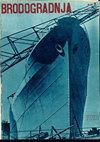替代推进系统的比较——以公共交通客船为例
IF 4.2
4区 工程技术
Q1 ENGINEERING, MARINE
引用次数: 5
摘要
河流的流量和河床断面的变化赋予了河流运输的独特特征。大多数内河船只使用传统的推进系统。发动机功率应按比例调整到最大的预期功率需求,这意味着发动机被迫在中等或低负荷下运行,在部分运行时间内几乎总是下游和上游。在这些情况下,发动机的工作点远不理想,因此有增加的比油耗。对于那些被迫频繁启停的船只来说尤其如此。上述情况的一个例子是在布达佩斯作为公共运输船运营的BKV-100型船。一项对计划路线的测量显示,在给定的环境条件下(水位、河流量等),船上安装的功率几乎是测量到的最大功率需求的两倍。由于这个原因以及下游和上游电力需求的差异,用替代推进系统取代现有的常规推进系统在技术上可能是值得的。在此基础上,对4种替代驱动系统与现有驱动系统的油耗和投资成本进行了比较。此外,还介绍了一种简单而有效的燃料消耗估算方法和简单的成本效益分析。本文章由计算机程序翻译,如有差异,请以英文原文为准。
COMPARISON OF ALTERNATIVE PROPULSION SYSTEMS - A CASE STUDY OF A PASSENGER SHIP USED IN PUBLIC TRANSPORT
The unique feature of river transport is given by the rivers' flow and the changing cross-sections of the riverbed. Most river vessels operate with a conventional propulsion system. Engine power should be scaled to the maximum expected power demand, which means that the engine is forced to run at medium or low load, almost always downstream and upstream for part of the operating time. In these cases, the engine's operating point is far from ideal, so there is an increase in specific fuel consumption. This is especially true for ships that are forced to stop and start frequently. An example for the circumstances mentioned above is the BKV-100 type ship operated at Budapest as a public transport vessel. A measurement on a schedule route revealed that with given environmental conditions (water level, river flow rate, etc.), the power installed in the vessel is almost double the maximum power demand measured. Due to this reason and to the differences in power demand of downstream and upstream, it may be technically worthwhile to replace the existing conventional propulsion system with an alternative propulsion system. Based on the measurements, in this paper the authors compare 4 alternative drive systems to the existing one with regards to fuel consumption and the investment costs. Beside this, a simple but effective fuel consumption estimation method and a simple cost-benefit analysis are also described.
求助全文
通过发布文献求助,成功后即可免费获取论文全文。
去求助
来源期刊

Brodogradnja
ENGINEERING, MARINE-
CiteScore
4.30
自引率
38.90%
发文量
33
审稿时长
>12 weeks
期刊介绍:
The journal is devoted to multidisciplinary researches in the fields of theoretical and experimental naval architecture and oceanology as well as to challenging problems in shipbuilding as well shipping, offshore and related shipbuilding industries worldwide. The aim of the journal is to integrate technical interests in shipbuilding, ocean engineering, sea and ocean shipping, inland navigation and intermodal transportation as well as environmental issues, overall safety, objects for wind, marine and hydrokinetic renewable energy production and sustainable transportation development at seas, oceans and inland waterways in relations to shipbuilding and naval architecture. The journal focuses on hydrodynamics, structures, reliability, materials, construction, design, optimization, production engineering, building and organization of building, project management, repair and maintenance planning, information systems in shipyards, quality assurance as well as outfitting, powering, autonomous marine vehicles, power plants and equipment onboard. Brodogradnja publishes original scientific papers, review papers, preliminary communications and important professional papers relevant in engineering and technology.
 求助内容:
求助内容: 应助结果提醒方式:
应助结果提醒方式:


